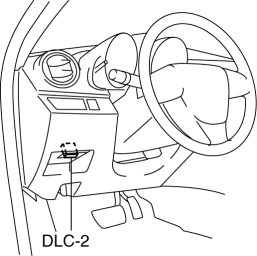Mazda 3 Service Manual: Engine Tune Up [Mzr 2.0, Mzr 2.5]
NOTE:
-
If the accelerator pedal is depressed continuously for a specified time, the engine speed may decrease to the idle speed. This is due to the fuel cut control operation, which prevents overheating, and it does not indicate a malfunction.
Engine Tune-up Preparation
1. Verify the following:
-
MTX: Shift lever is in neutral position.
-
ATX: Selector lever is in P or N position.
2. Warm up the engine to normal operating temperature.
a. Increase the engine speed to 2,5003,000 rpm
until the cooling fan starts running.
b. When the cooling fan starts running, release the accelerator pedal and wait until the cooling fan stops running.
3. Turn off all electrical loads.
4. Connect the M-MDS to the DLC-2.

Idle Speed Inspection
NOTE:
-
Idle speed is not adjustable.
-
Idle speed verification requires M-MDS.
1. Complete the engine tune-up preparation..
2. Verify that the idle speed (M-MDS: RPM) is within the specification..
-
Idle speed (MTX: Neutral position, ATX: P, N position)
-
600700 rpm (MTX), 650750 (ATX)
Ignition Timing Inspection
NOTE:
-
The ignition timing cannot be adjusted.
-
The M-MDS is required to verify the ignition timing.
1. Complete the engine tune-up preparation..
2. Verify the ignition timing (M-MDS: SPARKADV) using the PID/data monitor function of the M-MDS..
-
Ignition timing
-
MZR 2.0: Approx. BTDC 8°
-
MZR 2.5: Approx. BTDC 12°
3. Verify that ignition timing advances when the engine speed increases gradually.
Idle Mixture Inspection
1. Verify that the idle speed and ignition timing are within the specification..
2. Insert an exhaust gas analyzer into the tailpipe.
3. Verify that the CO and HC concentrations are within regulation.
-
CO concentration
-
Within the regulation
-
HC concentration
-
Within the regulation
Idle-up Speed Control Inspection
NOTE:
-
Idle speed is not adjustable.
-
Idle speed verification requires M-MDS.
1. Complete the engine tune-up preparation..
2. Verify that the engine speed (M-MDS: RPM) is within the specification when each load is applied. (The speed decrease just after the load is applied is not considered.).
-
If the engine speed is not within the specification when a specified load is applied, inspect the related input parts, wiring harnesses, and connectors.
-
Idle-up speed (MTX: Neutral position, ATX: P, N position)
-
A/C on: 700800 rpm (MTX), 650770 (ATX)
-
Electrical loads on: 650800 rpm
 Engine SST [Skyactiv G 2.0]
Engine SST [Skyactiv G 2.0]
1: Mazda SST number
2: Global SST number
Example
1:49 UN20 5072
2:205072
Holder
1:
2: 134-01049A
Evaporative emission system teste ...
 Engine Tune Up [Mzr 2.3 Disi Turbo]
Engine Tune Up [Mzr 2.3 Disi Turbo]
NOTE:
If the accelerator pedal is depressed continuously for a specified time,
the engine speed may decrease to the idle speed. This is due to the fuel cut
control operation, which preve ...
Other materials:
Theft Deterrent System Reading Freeze Frame Data
1. Connect the M-MDS (IDS) to the DLC2.
2. After the vehicle is identified, select the following items from the initialization
screen of the IDS.
Select Body.
Select "Burglar Service Functions".
3. Then, select the following item from the screen menu.
...
Front Center Speaker Inspection
1. Disconnect the negative battery cable..
2. Remove the following parts:
a. Upper column cover.
b. Instrument cluster.
c. Center panel.
d. Center cover.
e. Dashboard upper panel.
f. Front center speaker.
3. Verify the resistance between the front center speaker terminals.
...
Precaution [ABS]
1. Any one or a combination of the ABS warning and brake system warning lights
illuminates even when the system is normal.
Warning lights that may illuminate and/or flash
Cases in which the light may illuminate
Conditions in which the light will go ou ...
